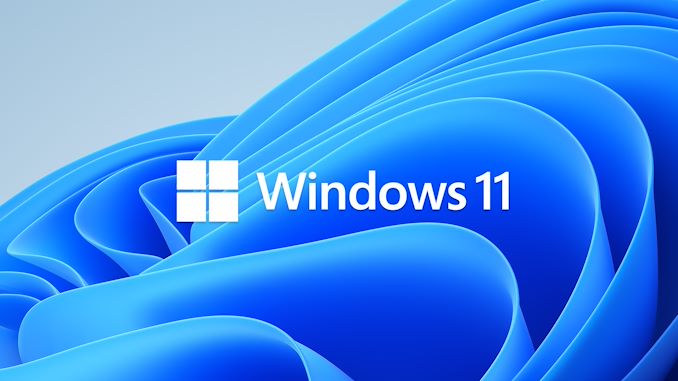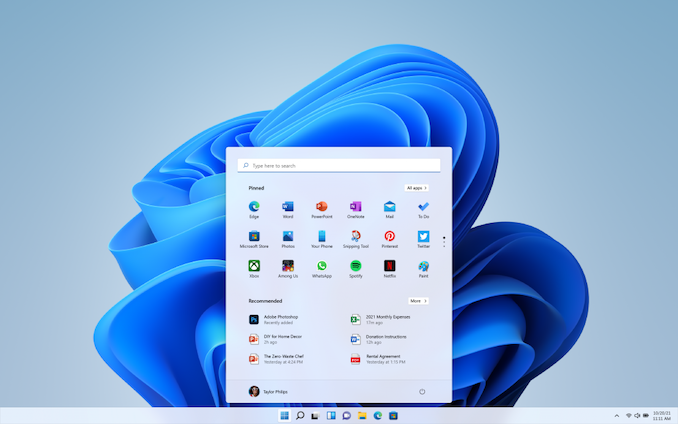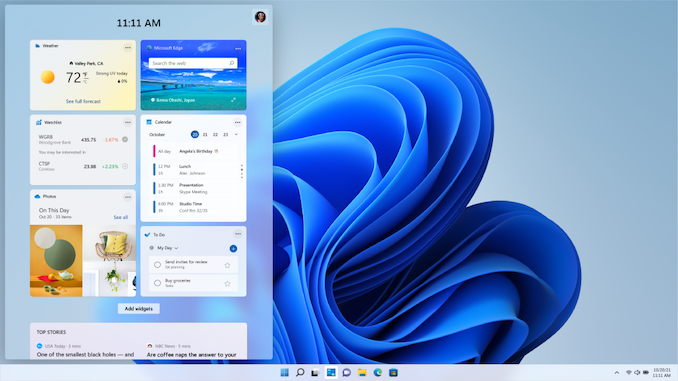What to Expect with Windows 11: A Day One Hands-On
by Brett Howse on October 4, 2021 4:00 PM EST- Posted in
- Software
- Operating Systems
- Windows
- Microsoft
- Windows 11

Tomorrow, Microsoft is officially launching Windows 11, the next installment of their operating system which underpins the majority of PCs in use today. Windows 10 has an install base of over 1 billion devices, and Windows 11 comes into existence in a much different place than its predecessor. After the much-maligned Windows 8 there was a sense of urgency and necessity which ushered Windows 10 into the world. Windows 11, on the other hand, comes into a market where most people are happy with Windows 10. So it raises the question: Why now?
When Windows 10 launched, it was said to be the final version of Windows, and future updates would be additive to Windows 10, rather than a new version number. But that was six years ago, and times have changed, as has the management and ownership of the Windows development team at Microsoft. For better or worse, the company has deemed that now is a good time to do a clean break again, with all of the animosity and angst that will bring to a good portion of their customers, especially businesses who may still be in the process of migrating to Windows 10.
The question is why now? What is new? Why is Microsoft choosing this moment to switch from the very successful Windows 10 and implement another upgrade cycle? Some of these questions can be answered, but others will take time.
Refreshed User Interface
The immediate change that everyone will notice is that Microsoft has completely revamped the user interface for Windows 11. They have apparently gotten tired of their obsession with flat, stark interfaces and moved to a much more colorful and expressive theme.
There are also major changes to the Start Menu and the taskbar. The Start Menu has ditched the live tile idea. Although a good idea on the now defunct Windows Phone platform, live tiles never really worked well on the desktop and could make it more difficult to find the application you were looking for since the icon would change. Instead, the Start Menu goes back to basic app icons, but now with the Start Menu, by default, centered in the middle of the display.
Live tiles have been replaced with Widgets and can be accessed via a Widget icon on the taskbar. Currently the selection of Widgets is only Microsoft ones, and it will be interesting to see if this expands over time.
Tablet Mode is now gone as well, so if you liked to use Windows 10 in its more touch-friendly mode, you will likely be disappointed.
The taskbar also moves from a left-justified look to being centered, and when more applications are opened, the icons already on the task bar will shift to the left to keep things centered. Apps can also no longer customize areas of the taskbar.
The taskbar can also no longer be moved from the bottom of the display if you were someone who liked to slide it to one of the other sides of the screen, which will likely disappoint a lot of people. When your user base is over 1 billion, if even only 1% of users used a feature, that’s still 10 million people that used that feature.
Overall, the new user interface is clean, colorful, and breathes some new life into what had become a bit stale in Windows 10. Functionally, it is not drastically different than Windows 10, although moving the Start Menu from the bottom left corner where it has been since Windows was first Windows is a bold change. The loss of Live Tiles seems like a downgrade in functionality, but it does make the interface more consistent and easier to access the applications you are looking for, with widgets hoping to take up the slack. But, there is a surprising amount of customization and features that are being dropped.












95 Comments
View All Comments
flyingpants265 - Monday, October 4, 2021 - link
Forgot to mention, the various error reporters and virus scanners and updaters are regularly using 50 to 100% CPU on my laptop, no matter how much I try to stop them.If there were a viable alternative, I would use it. A viable alternative means being able to run ALL windows applications, inside a Windows Explorer interface. Let me know when it happens. Linux has been a catastrophic failure, capturing only 2% market share - it's so good, you can't even give it away for free. Macs are alright.
GeoffreyA - Monday, October 4, 2021 - link
I find ShutUp10 useful in curtailing 10's behaviour; and OpenShell to get the classic Start menu back. No classic Start, no Windows. Concerning Calculator, if you'd like the one from 7 back, there's a download, I think, on Winaero.flyingpants265 - Monday, October 4, 2021 - link
Didn't need any of those three things in Windows 7. I honestly forget the difference between 7 and XP, but I remember not completely hating 7.GeoffreyA - Tuesday, October 5, 2021 - link
XP and 7 were class.AbRASiON - Tuesday, October 5, 2021 - link
My god!!!!!!!!!!!! The Windows 10 Calculator! I've had it, after years of this thing. I hit run, type calc, enter - why is it taking up to near 5 seconds to open this junk WHY?Thanks, I'm finally going to replace it.
flyingpants265 - Tuesday, October 5, 2021 - link
Good point about it taking 5 seconds to open. A lot of things in Windows 10 are like that. Replacing bits and pieces won't help if the underlying codebase for the shell, services and applications is just bad.GeoffreyA - Wednesday, October 6, 2021 - link
It's a UWP application likely written in C# and .NET, and will be slower than the classic Win32 calculator.XJDHDR - Tuesday, October 12, 2021 - link
The problem is your PC. Win10 calc opens instantly for me.Gigaplex - Monday, October 4, 2021 - link
"Linux has been a catastrophic failure, capturing only 2% market share - it's so good, you can't even give it away for free."Linux has around 85% of the mobile (ie phones) market share.
flyingpants265 - Monday, October 4, 2021 - link
Yeah, exactly. Because it has corporate backing. They ("Linux community") couldn't do it by themselves, they just haven't done anything since like 1983. Goes to show that it could have been done anytime, they just didn't want to do it.Incidentally, it was Google that turned computers from tools into commercialized toys with Android. In Windows I can customize nearly every single aspect of the UI, background processes, hotkeys, I can open multiple windows at the same time and move things around. Custom ROMs are garbage and just give you the illusion of customization in an extremely limited OS.